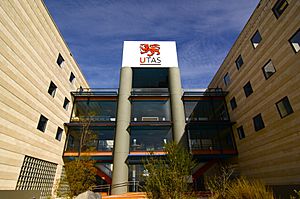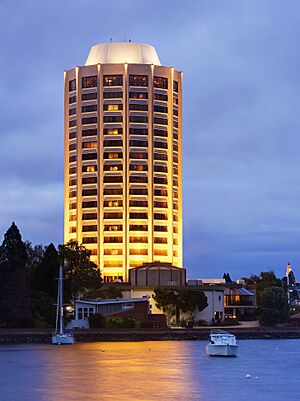Sandy Bay, Tasmania facts for kids
Quick facts for kids Sandy BayHobart, Tasmania |
|||||||||||||||
|---|---|---|---|---|---|---|---|---|---|---|---|---|---|---|---|

View of Wrest Point Casino and Sandy Bay
|
|||||||||||||||
| Population | 12,315 (2021 census) | ||||||||||||||
| Postcode(s) | 7005 | ||||||||||||||
| LGA(s) | City of Hobart | ||||||||||||||
| State electorate(s) | Clark | ||||||||||||||
| Federal Division(s) | Clark | ||||||||||||||
|
|||||||||||||||
Sandy Bay is a prestigious suburb of the city of Hobart, Tasmania, Australia, located immediately south of the central business district and adjoining Battery Point. Sandy Bay is bordered by the Derwent River to the east and is known for its beaches, including Nutgrove Beach, Long Beach, and Lords Beach.
Sandy Bay is one of Hobart's most affluent suburbs, home to some of Tasmania's most expensive real estate. It also contains student accommodations near the University of Tasmania's Sandy Bay campus and private schools, including Fahan School, The Hutchins School, and Mount Carmel College.
Sandy Bay is a key entry point to southern Hobart, connected by Sandy Bay Road, which runs from Davey Street to Taroona, where it becomes the Channel Highway. One of its most famous landmarks is the Wrest Point Hotel Casino, Australia’s first legal casino, opened in 1973.
Contents
History
The area now known as Sandy Bay was originally home to the Mouheneenner people. Early European settlers were granted land in the area in the early 19th century, with much of the land given to displaced Norfolk Islanders in 1808. Sandy Bay was known for its long beach, where horse races were held in the early 1800s. By the early 20th century, it had become an integral part of Hobart's urban growth, officially becoming part of the City of Hobart in 1914.
Sandy Bay Baths
Situated on Marieville Esplanade, the Sandy Bay Baths, built in 1906, were a key open-sea recreational facility for locals. They provided an important public space for swimming and relaxation and were a fixture of Sandy Bay until their demolition in 1965 to make way for modern developments, including rowing sheds for private schools.
Sandy Bay tram line
The Sandy Bay tram line, inaugurated in 1893, connected the suburb to Hobart’s city centre via Macquarie Street and Sandy Bay Road, terminating at Long Beach. The tramline was an essential part of public transport until 1952, when trams were phased out and the route was taken over entirely by electric trolleybuses. These trolleybuses operated until the mid-1960s, after which motorbuses took over.
Institutions and schools
Sandy Bay is home to several prestigious institutions and schools including:
- The Fahan School: An all-girls private school offering education from Kindergarten to Year 12, founded in 1935.
- The Hutchins School: A leading boys' private school, also offering Kindergarten to Year 12 education.
- Mount Carmel College: A Catholic girls' school catering for students from Kindergarten to Year 10.
- Sandy Bay Infant School: A public school with a focus on early childhood education.
- Waimea Heights Primary School: A public primary school with a strong reputation for academic achievement and community involvement.
University of Tasmania
The University of Tasmania (UTAS) has a significant presence in Sandy Bay. Although many of its faculties are being relocated to Hobart's central business district, the law school and STEM centre are staying at the Sandy Bay campus. The future of the broader campus remains a topic of debate, with various proposals for development, including housing.
Wrest Point Hotel Casino
Wrest Point Hotel Casino is a prominent landmark in Sandy Bay and is notable for being Australia's first legal casino. Originally opened as a waterfront hotel in the 1930s, Wrest Point underwent significant changes in the early 1970s. Following the 1968 Tasmanian casino referendum, where voters narrowly approved the introduction of casino gambling, plans were set in motion to develop Wrest Point into a casino complex.
The development was led by Federal Hotels, and in 1973, Wrest Point Casino officially opened. The building’s design, featuring an octagonal tower, was created by architect Roy Grounds and has since become a defining feature of Sandy Bay’s skyline. The casino complex also includes a hotel, multiple dining venues, and entertainment facilities, making it a key destination for visitors to Hobart.
The introduction of the casino was seen as a means to boost Tasmania’s tourism industry, attracting visitors from across Australia and internationally. Wrest Point continues to operate as a major entertainment hub, hosting events, conferences, and leisure activities.
Beaches
Sandy Bay is home to several popular beaches along the Derwent River foreshore, making it a key destination for recreational water activities in Hobart.
- Nutgrove Beach: One of the most family-friendly beaches in the area, Nutgrove Beach is a popular spot for swimming, picnicking, and kayaking. It has a calm shoreline, ideal for families and children. Nearby, there are barbecue facilities, playgrounds, and the popular Long Beach Reserve.
- Long Beach: Located adjacent to Nutgrove Beach, Long Beach is another major recreational hub for locals and visitors. The beach is often used for stand-up paddleboarding, walking, and swimming. It also serves as the venue for various local events throughout the year.
- Lords Beach: A small steep beach located towards the northern end of Sandy Bay, Lords Beach is known for its imposing concrete sea wall, built to stop coastal erosion and raised jetties.
- Red Chapel Beach: Situated near Wrest Point, this beach provides views of the iconic Wrest Point Casino. Red Chapel Beach offers a more secluded experience compared to Nutgrove and Long Beach.
These beaches are a key feature of Sandy Bay's lifestyle, attracting both locals and tourists alike for relaxation, exercise, and water sports.
Demographics
| Historical population | ||
|---|---|---|
| Year | Pop. | ±% |
| 2001 | 10,879 | — |
| 2006 | 11,332 | +4.2% |
| 2011 | 11,156 | −1.6% |
| 2016 | 11,927 | +6.9% |
| 2021 | 12,315 | +3.3% |
| Source: Australian Bureau of Statistics data. | ||
In 2021, the population of Sandy Bay was 12,315. External estimates project a resident population of 12,600 by 2024, with a population density of approximately 1,800 people per square km.
The median weekly household income in Sandy Bay was $1,721, compared to the national median of $1,746. Approximately 19.5% of households in Sandy Bay had a weekly income of less than $650, while 14.7% of households earned over $3,000 per week.
Sandy Bay is a predominantly Australian-born community, with 67.1% of residents born in Australia. Other common countries of birth include England (4.1%), China (3.0%), Malaysia (1.4%), and India (1.2%).
78.5% of people in Sandy Bay spoke only English at home, while 12.5% spoke other languages. Common non-English languages included Mandarin (3.2%), Cantonese (1.2%), and Italian (0.7%).
In terms of religious affiliation, 48.6% of people in Sandy Bay reported no religion, while 39.5% identified with Christianity. The largest Christian denominations were Catholicism (12.3%) and Anglicanism (10.1%). Other religions included Buddhism (2.1%) and Islam (0.8%).
Sport and recreation
Sandy Bay has a long history of supporting a variety of sports and recreational activities. The suburb's location near the Derwent River and its sporting facilities make it a centre for both water-based and land-based sports.
Sandy Bay Football Club
The Sandy Bay Football Club, known as the "Seagulls," was established in 1944 and competed in the Tasmanian Football League (TFL). The club had a period of success, winning eight premierships, with its strongest performances occurring between the 1960s and 1980s. The team played its home games at Queenborough Oval in Sandy Bay, which continues to be a key sports venue. The club disbanded in 1997 due to financial difficulties. However, its contribution to Tasmanian football is remembered through reunions and community events.
Cricket
Cricket is also popular in Sandy Bay, with matches played at Queenborough Oval, the home ground of the Sandy Bay Cricket Club. The club participates in the Tasmanian Premier League and has been involved in local competitions for many years.
Rowing and sailing
Sandy Bay’s waterfront location supports a strong tradition of rowing and sailing. The suburb is home to the Royal Yacht Club of Tasmania (RYCT) and the Derwent Sailing Squadron, both of which host local and international sailing events, including the finish of the Sydney to Hobart Yacht Race.
The Sandy Bay Rowing Club, founded in 1906, is another key organisation in the area, with members regularly competing in state and national rowing events.
Tennis and bowls
Tennis is well-established in Sandy Bay, with courts available at the University of Tasmania campus, and local clubs. Lawn bowls is also played at the Sandy Bay Bowls Club, which provides opportunities for both competitive and social matches.
Recreational Facilities
Sandy Bay offers a range of recreational facilities, including the Nutgrove Beach Reserve, which provides walking paths, playgrounds, and picnic areas. The annual Sandy Bay Regatta, held on Australia Day, is a long-standing event featuring sailing races, water sports, and family activities.
Real estate
Sandy Bay’s property market is among the most expensive in Tasmania. The suburb features a mix of high-end waterfront homes, luxury properties, and student accommodation. Streets like Osborne Esplanade, Churchill Avenue, and Derwentwater Avenue are known for their multimillion-dollar residences. The "Golden Mile" along Sandy Bay Road is particularly sought after for its views of the Derwent River and proximity to Hobart’s city centre. As of 2024, the median house price in Sandy Bay was over $1.5 million, making it one of the most desirable locations in Tasmania.
Transport and infrastructure
Sandy Bay is well-connected by its road network, with Sandy Bay Road serving as the primary route linking the suburb to Hobart’s city centre and southern regions. The area also benefits from cycling paths and pedestrian walkways, supporting a range of transport options for residents and visitors.
Metro Tasmania operates regular bus services along Sandy Bay Road, linking the suburb to Hobart's city centre and surrounding areas.
In 2028, a new ferry terminal is expected to be completed at Wrest Point as part of a broader plan to improve public transport along the Derwent River. This ferry terminal aims to reduce traffic congestion and provide an alternative transport option for residents and visitors.
Notable People
Sandy Bay has been home to several prominent individuals, including:
- Bennett Brook (1912–1995) – Eminent Tasmanian surgeon and public health advocate.
- Marta Dusseldorp – Actress known for her work on A Place to Call Home.
- Michael Ferguson – Politician, former Deputy Premier of Tasmania.
- Errol Flynn (1909-1959) – Hollywood actor, who spent part of his early childhood in Sandy Bay.
- Sir Guy Green – Former Governor of Tasmania.
- Louise Lovely (1895-1980) – Australian actress and one of the first silent film stars.
- Lloyd Rees (1895-1988) – Landscape painter who twice won the Wynne Prize for his landscape paintings.
- Grace Tame – Advocate and 2021 Australian of the Year.
- Ben Winspear – Actor and director.







